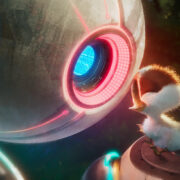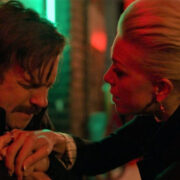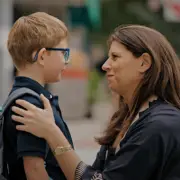THE INNOCENTS: The Horrors of Childhood
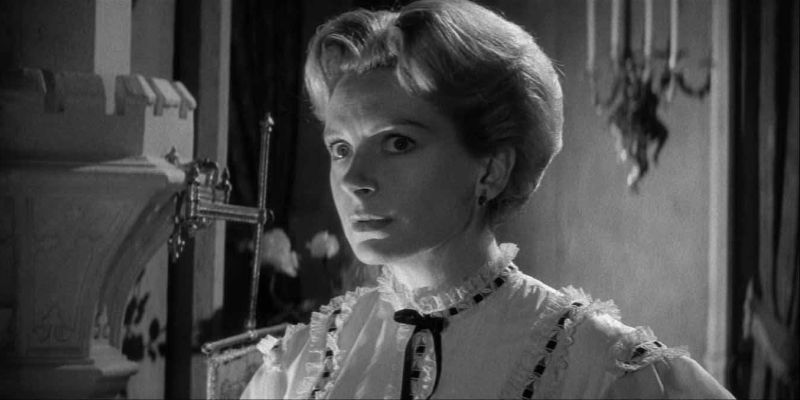
Amanda Garrett is a freelance writer with a passion for…
Miss Giddens (Deborah Kerr), the new governess for two orphaned children in Victorian England, arrives at their idyllic country estate in the beginning of the psychological horror film, The Innocents (1961). The naive young woman, who has a lived a solidly middle class existence as a vicar’s daughter, marvels at the stately home and spacious grounds. Everything, including her two young charges, seems innocent and perfect. Then Miss Giddens glides past a perfectly arranged bouquet of roses. The fresh blooms wither and fall to the ground, a dark hint of things to come.
The Innocents, brilliantly directed by Jack Clayton from Henry James novella The Turn of the Screw, is one of the best classic horror films. In some ways it is a traditional ghost story filled with virtually every haunted house trope, including candelabras, billowing curtains, and specters tapping on window panes; but it transcends its Gothic setting to become the story of what writer Christoper Frayling termed a “shattered Eden.” Miss Giddens soon finds out that behind the idyllic exterior of country life, there lies dark tales of lust, murder, and childhood innocence lost.
A Tale of Shattered Innocence
The Innocents begins with Miss Giddens taking on a job as the new governess at Bly House, a country estate where a rich man (Michael Redgrave) keeps his orphaned niece and nephew. The uncle (significantly, he never has a name in the movie) wants nothing to do with the children; instead, he prefers the whirl of social life in London and Italy. He puts Miss Giddens in complete charge of the affairs at Bly. When she arrives, she soon finds that her two young charges, Flora (Pamela Franklin) and Miles (Martin Stephens), may be in contact with the ghosts of the previous governess and valet, who both died in a mysterious manner.

James wrote The Turn of the Screw as a Christmas ghost story (haunted Yuletide tales are an English tradition) to amuse his literary friends. The creepy story became a major success both among the public and the critics, and solving the story’s central mystery became a popular parlor game among the intelligentsia. The story inspired a successful stage adaptation by William Archibald, which changed James‘ original title to The Innocents.
Clayton, who had worked his way up through the ranks of British cinema, decided to adapt The Innocents to the big screen after his first movie, Room at the Top (1959), was an international hit. Archibald‘s play was a creaky melodrama that featured the ghosts actually grasping characters hands and attempting to drag them away. Clayton knew this would be laughable on screen, so he hired American writer Truman Capote to adapt the screenplay. Crucially, Capote made the ghosts much more ambiguous – it is unclear throughout the film whether the phantoms are real or just figments of Miss Giddens’ overactive imagination – and he introduced the concept of tarnished innocence, which became the movie’s central theme.
Today, The Innocents is often referred to as a psychosexual thriller, and while that’s somewhat true, the movie really isn’t that racy even by 1961 standards. Instead, it is about the painful journey from childhood to adulthood, and all of the confusing emotions, including sexuality, that come with growing up. Flora and Miles were both emotionally scarred by the tragic events at Bly House. The governess and valet were their surrogate parents, and they are both dealing with the grief of their unexpected and violent passing. Also, the valet and the governess were having a romantic liaison, and the children were probably exposed to adult sexuality. Miles especially seems to have picked up on this: the valet was something of a ladies’ man and Miles copies his behavior by flirting, teasing, and even at one point, kissing Miss Giddens in a very adult manner.
However, the real subject of The Innocents is Miss Giddens. In many ways, she is more childlike than her young charges (while Kerr is brilliant in the part, at age 39, she was much too old to play the governess, who is supposed to be a teenager). Miss Giddens has led a sheltered existence – this is the first time she has lived apart from her parents – and she seems to be overawed by the grandeur of Bly House and the persuasive charm of the childrens’ uncle.
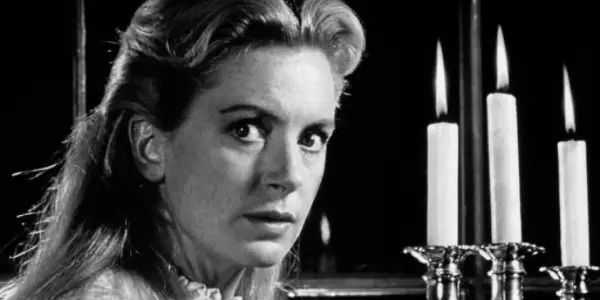
Most importantly, Miss Giddens is an innocent when it comes to human nature. She does not understand that even the best behaved children act out at times, and she seems not to understand adult relationships at all. Anecdotal evidence suggests that most unmarried Victorian women were not given any sex education, and Miss Giddens, who is attracted to a portrait of the darkly handsome valet, is in the grip of emotions that she does not understand. She continuously digs for information about the governess and the valet’s relationship. At one point Miles calls her “dirty minded,” and her fevered imagination leads her further and further into becoming dangerously agitated and unstable.
A Groundbreaking Horror Film
Even if you don’t care about the complex psychological dynamics in The Innocents, this movie is a great Halloween chiller. It’s certainly not a gut-bucket horror movie, but its old-fashioned scares are real. The movie is solidly within the haunted house genre, but unlike most of those films, Clayton doesn’t titillate the audience with cheap thrills. It is all about atmosphere, which is brilliantly created by the wide-screen photography of cinematographer Freddie Francis and pioneering sound technology by Daphne Oram (this is a film that is absolutely worth watching on Blu-ray to get the complete effect). The Innocents has many memorable set pieces that are seminal to the horror genre, including a chilling poetry recital by the children and the ghostly presence of the drowned governess, all wet and dressed in black, beckoning to Flora from across a pond.
Clayton and his team use all of their technical skills to create an insular world in The Innocents. The film never leaves the ground of Bly House except for trips to church, which places the audience in the same claustrophobic atmosphere as Miss Giddens. Along with her, we marvel at the beauty of Bly House (filmed on location at Sheffield Park in Sussex), and strain to see the shadowy figures peaking through windows and peering over rooftops. Along with her, we shiver at the chill of an autumn evening and feel the ghostly presence that withers the blooms on the rose.
What is your favorite haunted house movie? If you’ve seen The Innocents, what is your interpretation of the film? There are about a hundred more ways to look at this movie than what I outlined in the article.
The Innocents is available on DVD and Blu-ray.
(top image source: 20th Century Fox)
Does content like this matter to you?
Become a Member and support film journalism. Unlock access to all of Film Inquiry`s great articles. Join a community of like-minded readers who are passionate about cinema - get access to our private members Network, give back to independent filmmakers, and more.
Amanda Garrett is a freelance writer with a passion for classic films. You can catch her writing reviews and features at Film Inquiry or at her website, Old Hollywood Films.



